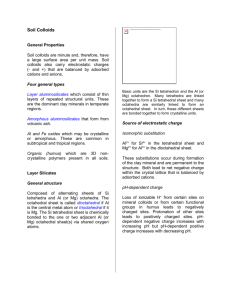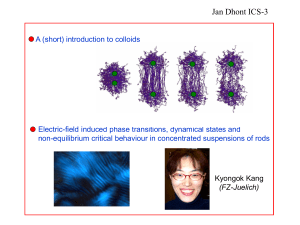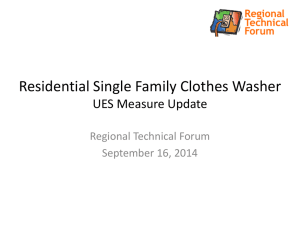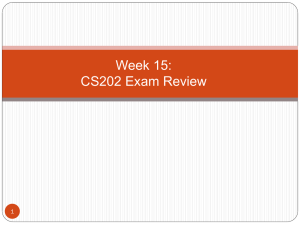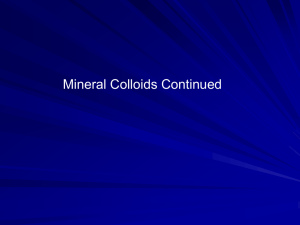Soil Colloids
advertisement
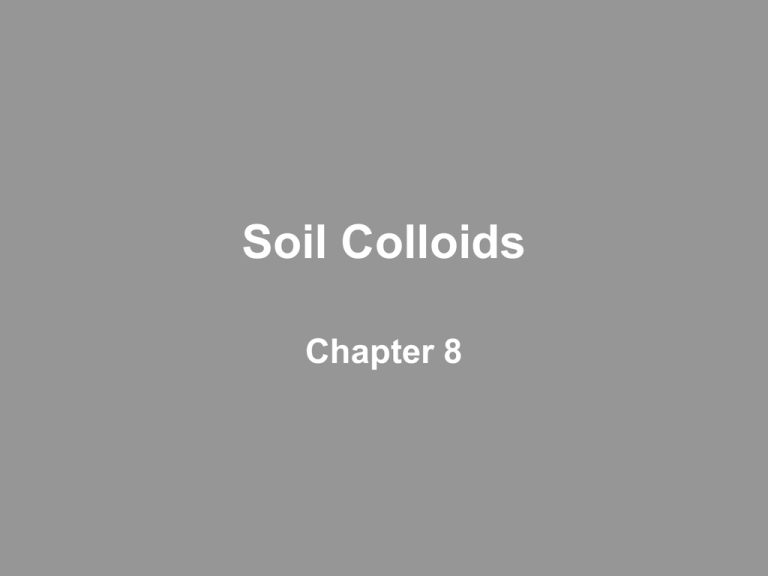
Soil Colloids Chapter 8 Ion exchange Cation exchange capacity Anion exchange capacity Types of soil colloids Emphasis on layer silicate minerals Types and properties of layer silicates 1:1 2:1 2:1:1 Types of electrostatic charge Permanent (isomorphic substitution) pH-dependent Acidic and basic cations and soil acidity Small so BIG SURFACE AREA / mass Electrostatic charges (- / +) so Adsorb ions Usually more Adsorbed cations and anions Not stuck permanently, irreversibly and for ever and ever on colloids Can trade places with other cations and anions in solution Cation Exchange Equilibrium between cations in solution and adsorbed on colloids 2+ + + █Ca2+ +2K Ca2+2+++ 2K █2K++ Ca + 2K Ca - charged sites of a colloid These equilibria are complex, involving all exchangeable species. The above is an example binary exchange reaction for which an equilibrium constant can be written as KK-Ca = [Ca2+][K+ad]2 / [K+]2[Ca2+ad]. If you’ve had 2nd semester chemistry or remember high school chemistry it should make sense. Anion Exchange Like cation exchange - - █SO SO442-2- ++█2Cl SO42-42-+2Cl + 2Cl SO 2Cl + charged sites Since a decrease in solution concentration of a nutrient cation or anion by plant uptake or leaching tends to cause release of the same type ion into solution from colloids (this is accompanied by replacement on the colloid by a different type cation or anion), the adsorbed ions are a reservoir of nutrients. Much greater quantity so adsorbed than in the soil solution. Are adsorbed cations and anions important to plant nutrition? Does ion exchange replenish the soil solution with nutrient ions? Does ion exchange slow the movement of charged contaminants? If a portion of a substance in the soil is distributed between solution and solid (adsorbed to) phases, its mobility must be less than if it were all in solution. Is a soil with a lot of adsorbed ions more fertile than a soil with very few adsorbed ions? Does a charged contaminant move more slowly in a soil with a high capcity to adsorb ions than in a soil with a low capacity to adsorb ions? Yes to the first, assuming these were nutrient ions and certainly yes to the second. Cation Exchange Capacity (CEC) These are the units in which the concentration of exchangeable cations in a soil are expressed, particularly cmol(+) kg-1. The others are probably archaic but notice that they are numerically the same. Milli-moles (+) charge / 100 g soil Milli-equivalents (meq) + / 100 g soil An equivalent is a mole of reactive units, in this case, charge. Is a centimole + charge / kg the same? cmol (+) / kg How do you measure CEC? Or AEC? In principal, this is a straightforward matter but there are complications in practice. The basic idea is that you use cation exchange to force all initially adsorbed cations into solution, separate solution from soil (like filter) and measure the concentration of all cations in solution. This requires use of a cation in solution that is not very common in the soil and it requires a high concentration of it. Look back at the example cation exchange reaction and notice that if the concentration of K+ was very high, the extent to which Ca2+ would be displaced into solution would be greater than if the concentration of K+ were modest. However, there is a problem with determining acidic cations like H+ and Al3+ in this way. A portion of these cations is very strongly held by adsorption onto colloids so that even a very high concentration of displacing cations won’t drive the exchange reaction to completion. However, alternatives exist to deal with this. For base cations, ammonium, NH4+, is the typically cation used to displace them. AEC is done the same way but with a displacing anion, of course. CEC is sum Acidic + basic cation charges / kg cmol (+) / kg Depends on Types of colloids Amounts of colloids pH It should make sense that different colloids likely have different CECs (and AECs). Thus, the relative amounts of different colloids determine the CEC. However, the charges on colloidal particles partly depend on the concentration of H+ in solution (i.e., pH, which is –log[H+]) Types of colloids Sources of charge permanent pH-dependent Types Layer aluminosilicates Amorphous aluminosilicates Al and Fe oxides Organic (humic) These are the general types of soil colloids. The layer aluminosilicates are crystalline, however, amorphous ones have limited and interrupted crystal structure. Strictly, besides oxides there are related non-siliceous minerals, like hydroxides and oxy-hydroxides, including ones besides just Al and Fe forms. Layer Aluminosilicates Alternating sheets of Si tetrahedra and Al (or Mg) octahedra Carry electrostatic charges due to Isomorphic substitution pH-dependent ionization or protonation Isomorphic substitution 3+ 4+ Al for Si in tetrahedral layer 2+ 3+ Mg for Al the octahedral layer What charge (+ or -) does the crystal carry? Balanced by cations? Is this source of charge permanent? Substitution of a lower valence cation for a higher valence cation during the formation of the crystal results in a deficit of positive charge relative to negative charge carried by the O and OH in the structure. Thus, the charge is – and it is permanent to the crystal structure. \ \ Al – OH Al – O- + H+ / / \ \ Al – OH + H+ Al – OH2+ / / pH dependent charges Besides permanent charge there are functional groups on the surfaces of colloids that can ionize or protonate to give rise to - / + charge. Here is a common example, surface Al–OH groups. Under conditions of higher soil pH (i.e., low concentration of H+), they tend to dissociate as in the top reaction. But when the pH is low, the O tends to be protonated by H+ from solution, giving a + site. There are lots of functional groups, both on mineral and organic colloids that do this. Tetrahedral sheet Octahedral sheet Three types of layer silicates 1:1 2:1 2:1:1 Having said a bit about electrostatic charges, let’s look at the common layer aluminosilicate minerals. These are they. 2:1 layer silicates Unit consists 1 octahedral sheet between 2 Si tetrahedral sheets d Certain types expan 2:1 Types This is a cutaway showing interlayer space between two units of a 2:1 type mineral. In this case, the stack of crystal units are shown to be able to expand, imbibing water in between adjacent crystals. Some 2:1 do this, others don’t. Those can are responsible for macroscopic shrinking and swelling behavior. Three types of 2:1 minerals Smectite Vermiculite Illite 2:1 Types Smectite Units weakly held together by cations Expand when adsorb water between units 2:1 Types, Smectite Big CEC Highly plastic and swelling Does this soil have a lot of smectite in it? 2:1 Types Vermiculite Even bigger CEC More isomorphic substitution Most of the isomorphic substitution in smectite is in the octahedral layer and these expand. The CEC of vermiculite is bigger and a lot of it is due to substitution in the tetrahedral layers. Does vermiculite expand as much as smectite? Very little, in fact. Apparently, the higher density of negative charge located very near the surface of the crystal face (tetrahedral sheet) leads to higher electrostatic attraction for cations in the interlayer space. The mutually strong attraction by two adjacent crystals for these cations greatly limits the extent to which water enters the interlayer space and causes expansion. Make sense? 2:1 Types, Vermiculite No because Strong affinity for cations that bridge tetrahedral layers Limited-expansion Illite Isomorphic substitution in Si tetrahedral sheet Geometry favors + adsorption of K at interlayer positions Holds units tightly together This is much the same thing as with vermiculite, however, the presence of K+ leads to especially strong bridging of adjacent crystals. See next slide. These are different representations of the silica tetrahedral sheet. Notice the hole-like features that some call siloxane cavities. K+ has just the right ionic radius to fit into these. Thus, electrostatic attraction between it and the isomorphic negative charge (much of it in the tetrahedral sheet) leads to very strong bridging between one crystal unit of illite and its neighbor. Thus, illite does not expand. 2:1 Types, Illite By the way, surface area is measured from gas adsorption. Nonexpanding Whereas smectite has open interlayer space, illite does not. Thus, much of the planar area of the tetrahedral layers in illite is not exposed to the gas. Smaller surface area than smectite or vermiculite CEC much less than other 2:1 minerals Further, the K+ in the interlayer space is not exchangeable. Thus, the high amount of negative charge (high extent of isomorphic substitution) cannot be measured by summing the charge of cations released by CEC determination. 1:1 layer silicates 1 Si tetrahedral sheet 1 Al octahedral sheet Adjacent units H-bonded together Os from the tetrahedral sheet of one crystal H-bond with the –OHs of the octahedral sheet of the neighboring crystal. If adjacent crystal units are H-bonded together, do 1:1 minerals expand? Little plasticity or swelling Small CEC Little isomorphic substitution And since there is little isomorphic substitution, most of the CEC is due to pH-dependent charge that arises from ionization of edge –OHs. 2:1:1 minerals Additional octahedral sheet (2:1:1) contains Mg Nonexpanding and fairly low CEC Less common than the others. Review Cation Exchange Equilibrium between cations in solution and adsorbed on colloids 2+ 2+ + █2K++ 2++2K+ + Ca2+ █Ca Ca + 2K Ca + 2K - charged sites of a colloid CEC is sum Acidic + basic cation charges / kg cmol (+) / kg Depends on Types of colloids Amounts of colloids pH Types Layer aluminosilicates Amorphous aluminosilicates Al and Fe oxides Organic (humic) Tetrahedral sheet Octahedral sheet Three types of layer silicates 1:1 2:1 2:1:1 Three types of 2:1 minerals Smectite expanding, high CEC Vermiculite limited expansion, higher CEC Illite not expanding, trapped K+ 1:1 layer silicates 1 Si tetrahedral sheet 1 Al octahedral sheet Adjacent units H-bonded together 2:1:1 minerals Additional octahedral sheet (2:1:1) contains Mg Nonexpanding and fairly low CEC Formation and stability of mineral colloids Primary minerals 2:1 clays 1:1 clays Oxides weather to which weather to which weather to Thus, soils in mildly weathering climates tend to have minerals towards the top of this sequence, and soils in harshly weathering climates (lots of water and high temperatures), tend to have minerals towards the bottom. For edification, check out Jackson-Sherman weathering sequence. More on Electrostatic Charges Permanent You know negative charges come from 3+ 4+ isomorphic substitution, like Al for Si or Mg2+ for Al3+ But what if Al3+ substitutes for Mg2+? What do you get? Refer to next slide. There are types of octahedral sheets that contain Mg2+ as the central cation. These are called trioctahedral and those with Al3+ are called dioctahedral. Basically, the ideally electro-neutral structure in a trioctahedral sheet requires 1½ times as many Mg2+ as there are Al3+ in a dioctahedral sheet. Thus, isomorphic substitution of the higher valence Al3+ for Mg2+ results in an excess of + charge in the crystal lattice, which must be balanced by adsorption of anions from solution. pH-dependent Negative charge Ionization of H from –OH on surface of oxides and edges of silicate clays Al—OH → Al—O- + H+ Ionization of –OH and –COOH on humic colloids O O ║ ║ --C—OH → --C—O- + H+ Positive charge Protonation of –OH to give OH2+ Oxide surfaces and silicate clay edges Al—OH + H+ → Al—OH2+ Does CEC increase or decrease as pH increases? What about AEC? Think of it this way –permanent charge is unaffected, right, but as the concentration of H+ in solution decreases (i.e., pH increases), whatever ionizable H there is on colloidal surfaces tends to ionize, creating negative sites and making the colloid more negative. So, the capacity of the colloid to adsorb cations increases, i.e., the CEC increases. The AEC is opposite. As the concentration of H+ in solution increases, more and more sites become protonated, increasing the positive charge on the colloid and its capacity to adsorb anions from solution. Charge at pH 7 Type Perm Humus 20 Vermiculite 140 Smectite 95 lllite 20 1:1 minerals 0.4 Oxides 0 pH-dep Total 180 10 5 6 7.6 4 200 150 100 30 8 4 This is somebody’s breakdown of CEC into permanent and pH-dependent components. The notion that organic colloids (humus) have permanent charge makes no sense since isomorphic substitution is not applicable. What, however, makes sense is that even at very low pHs (not to be encountered except in some drained wetlands or contaminated sites) some of the acidic functional groups on soil organic matter are sufficiently acidic to be ionized. More on CEC 2+ 2+ + + Ca , Mg , K and Na are basic cations + 3+ H and Al are acidic cations Percentage of CEC that is made up of basic cations is called Percentage base saturation %BS Here’s an example calculation: Extractable cations Ca2+ Mg2+ K+ H+ ----------- cmol(+) kg-1----------2 1 1 1 For this case, CEC = 5 cmol(+) kg-1 and there are 4 cmol(+) kg-1 due to the bases so the %BS = 4 / 5 x 100% = 80% True or False As pH ↑ %BS ↑ True. If the pH increases, there is less acidity in the system (H+ and other acidic cations, e.g., Al3+, both in solution and adsorbed on colloidal surfaces). Thus, since the negative charge on colloids must be satisfied by adsorbed cations, decreased concentration of acidic cations means increased concentration of basic cations. Also, with increasing pH the negative charge on colloids increases, compounding the effect of increased concentration of adsorbed bases. Soil A Soil B cmol (+) / kg Basic cations Acidic cations 90 10 5 5 Which soil has the lower pH? Which soil is more fertile? Let’s just say likely lower pH. A has a %BS = 90 and B, 50. Thus, B likely has the lower pH. The matter of fertility is clearer since most basic cations are nutrients –A has 18x as many.
